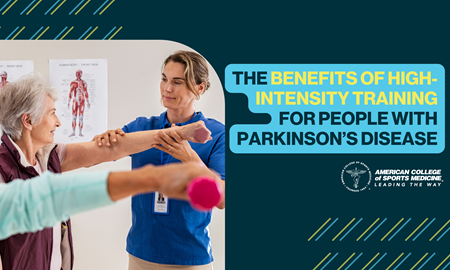by
Greg Margason
| Apr 19, 2023

What is Parkinson’s disease?
Parkinson’s disease (PD) is a progressive neurodegenerative condition associated with low levels of the neurotransmitter dopamine, due to damage that occurs in a part of the midbrain known as the substantia nigra. People living with PD will have a combination of motor and nonmotor symptoms that can adversely affect activities of daily living, functional capacity and/or physical functional. Common motor symptoms include slowed movement (known as bradykinesia), postural rigidity (resulting in balance decrement) and tremor at rest. Nonmotor symptoms can include fatigue, cognitive deficit/dementia and autonomic/enteric nervous system dysfunction. The primary methods of management for PD include a variety of medications and exercise.
Exercise has been shown to be one of the most effective methods for managing PD and can result in slowed progression of the disease, improvement in motor and nonmotor control, and improved quality of life. Common exercise programs for PD include aerobic activity, resistance training, flexibility, and neuromotor exercise such as boxing, dance, tai chi or yoga. Recently, high-intensity interval training (HIIT) has been shown to have equal or greater improvements compared to moderate-intensity exercise for persons with PD and should be considered as a programming option for exercise professionals.
What is HIIT training?
HIIT is a time-efficient training method that uses a combination of short-duration, higher-intensity intervals followed by recovery intervals at longer duration and lower intensity at repeat frequencies. Typical intensities for HIIT include 85-95% age-predicted heart rate maximum (APHRM). Intensity of programming is relative to each person and does not always have to be “high skill” activities such as sprinting. For instance, a person with PD may be able to achieve APHRM within HIIT ranges by increasing treadmill walking speeds by 20% (referred to as forced intensity) and returning to a lower workload for recovery. People with earlier-onset PD or less severe cases will be able to perform higher skill activities such as treadmill running. HIIT can also be performed on a stationary cycle or seated rower if balance decrements exist.
Is HIIT beneficial for people with PD?
Recent research indicates that HIIT may contribute to greater neurogenesis in people with PD at a higher magnitude when compared to moderate- or low-intensity exercise. HIIT may increase hippocampal activity of the brain, which is associated with improved mood, memory and cognition; these in turn are linked to slowed progression of dementia. When activated, the hippocampus may also secrete greater amounts of brain-derived neurotropic factor (BDNF). BDNF may be associated with growth of new neurons and improved neural function in the aforementioned areas of the brain. Additionally, HIIT training can result in greater dopamine production and receptor sensitivity, which has been shown to improve motor control both during exercise and a few hours following the exercise session. This carryover effect can be neuroprotective in nature for people with PD and contributes to greater motor control and improved physical function following a HIIT session. Other benefits associated with HIIT in PD include improvements in aerobic and muscular fitness that is similar to gains made in people without PD.
Programming HIIT for people with PD
When considering HIIT training for clients with PD, the exercise professional must consider the following:
- Disease variability — Motor and nonmotor symptoms may fluctuate daily or session by session. Be sure to be flexible with HIIT programming based on how a person is feeling that day.
- Medications — Different medications can cause adverse effects or complicate tolerance and adherence to exercise. PD medications can have on-off fluctuations with motor control and may cause dyskinesia (uncontrolled and involuntary movements) when taken long term.
- Cognitive function — Many people with PD may experience cognitive deficit. The exercise professional needs to keep instructions simple and allot time to repeat instructions throughout the session, if necessary.
- Fitness level — People with PD who have earlier onset of disease or have greater initial fitness can typically participate in more aggressive HIIT programs. In the case of lower fitness or more severe PD, HIIT programming will start more conservatively and progress as tolerated.
- Session timing — Exercise professionals need to ask the client how they are feeling prior to the exercise session. It is recommended that HIIT training be performed at a time of day when the client “feels best” or typically experiences the fewest motor symptoms.
Exercise professionals must educate the client on the benefits of HIIT and never force a mode of exercise on a person that they may not be interested in participating in. If complications arise, the exercise professionals must communicate efficiently with physicians, care team members and caregivers. HIIT training should not replace other modes or intensities of exercise but needs to be considered when working with people who are managing PD through exercise.
Additional Resources:
Blog | Practical Strategies to Implement Parkinson’s Exercise Guidelines
Infographic | Exercise Recommendations for Parkinson’s Disease
EIM Handout | Being Active When You Have Parkinson’s Disease
Related CEC Courses:
Coaching HIIT — A Practical Approach to Programming (10 CECs)
Exercise Guidelines | Parkinson’s Disease (1 CEC)

Paul M. Gallo, Ed.D., FACSM, ACSM-EP, ACSM-CEP, ACSM-GEI, is the director of exercise science and wellness at Norwalk Community College in Norwalk, Connecticut; adjunct faculty at Teachers College Columbia University, in New York City; and a past president of ACSM’s New England Chapter. Dr. Gallo is the chair of ACSM’s CCRB-Continuing Professional Education Subcommittee, associate editor-in-chief of ACSM’s Health & Fitness Journal® and associate editor for the Journal of Clinical Exercise Physiology. He strongly believes in the importance of translating science to evidence-based practice within the health-fitness and exercise science fields.